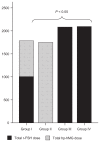Observational Study to Assess the Therapeutic Value of Four Ovarian Hyperstimulation Protocols in IVF After Pituitary Suppression with GnRH Antagonists in Normally Responding Women
- PMID: 24453506
- PMCID: PMC3888073
- DOI: 10.4137/CMRH.S6339
Observational Study to Assess the Therapeutic Value of Four Ovarian Hyperstimulation Protocols in IVF After Pituitary Suppression with GnRH Antagonists in Normally Responding Women
Abstract
Objective: To compare the clinical results of four different protocols of COH for IVF-ICSI in normovulatory women, using in all cases pituitary suppression with GnRH antagonists.
Materials/methods: A single center, open label, parallel-controlled, prospective, post-authorization study under the approved conditions for use where 305 normal responders women who were candidates to COH were assigned to r-FSH +hp-hMG (n = 51, Group I), hp-hMG (n = 61, Group II), fixed-dose r-FSH (n = 118, Group III), and r-FSH with potential dose adjustment (n = 75, Group IV) to subsequently undergo IVF-ICSI.
Results: During stimulation, Group IV needed significantly more days of stimulation as compared to Group II [8.09 ± 1.25 vs. 7.62 ± 1.17; P < 0.05], but was the group in which more oocytes were recovered [Group I: 9.43 ± 4.99 vs. Group II: 8.96 ± 4.82 vs. Group III: 8.78 ± 3.72 vs. Group IV: 11.62 ± 5.80; P < 0.05]. No significant differences were seen between the groups in terms of clinical and ongoing pregnancy, but among patients in whom two embryos with similar quality parameters (ASEBIR) were transferred, the group treated with hp-hMG alone achieved a significantly greater clinical pregnancy rate as compared to all other groups [Group I: 31.6%, Group II: 56.4%, Group III: 28.7%, Group IV: 32.7%; P < 0.05].
Conclusions: Although randomized clinical trials should be conducted to achieve a more reliable conclusion, these observations support the concept that stimulation with hp-hMG could be beneficial in normal responders women undergoing pituitary suppression with GnRH antagonists.
Keywords: GnRH antagonist; IVF/ICSI; controlled ovulation hyperstimulation; embryo quality; highly purified menotropin; recombinant-FSH.
Figures
Similar articles
-
Risk of severe ovarian hyperstimulation syndrome in GnRH antagonist versus GnRH agonist protocol: RCT including 1050 first IVF/ICSI cycles.Hum Reprod. 2016 Jun;31(6):1253-64. doi: 10.1093/humrep/dew051. Epub 2016 Apr 8. Hum Reprod. 2016. PMID: 27060174 Clinical Trial.
-
Corifollitropin alfa followed by highly purified HMG versus recombinant FSH in young poor ovarian responders: a multicentre randomized controlled clinical trial.Hum Reprod. 2017 Nov 1;32(11):2225-2233. doi: 10.1093/humrep/dex296. Hum Reprod. 2017. PMID: 29040589 Clinical Trial.
-
Recombinant LH supplementation to a standard GnRH antagonist protocol in women of 35 years or older undergoing IVF/ICSI: a randomized controlled multicentre study.Hum Reprod. 2013 Oct;28(10):2804-12. doi: 10.1093/humrep/det266. Epub 2013 Jul 9. Hum Reprod. 2013. PMID: 23838159 Clinical Trial.
-
The impact of adding hp-hMG in r-FSH started GnRH antagonist cycles on ART outcome.Gynecol Endocrinol. 2019 Oct;35(10):869-872. doi: 10.1080/09513590.2019.1600667. Epub 2019 Apr 11. Gynecol Endocrinol. 2019. PMID: 30973022
-
FSH: urinary and recombinant.Eur J Obstet Gynecol Reprod Biol. 2004 Jul 1;115 Suppl 1:S30-3. doi: 10.1016/j.ejogrb.2004.01.023. Eur J Obstet Gynecol Reprod Biol. 2004. PMID: 15196713 Review.
Cited by
-
Interplay Between mTOR and Hippo Signaling in the Ovary: Clinical Choice Guidance Between Different Gonadotropin Preparations for Better IVF.Front Endocrinol (Lausanne). 2021 Jul 21;12:702446. doi: 10.3389/fendo.2021.702446. eCollection 2021. Front Endocrinol (Lausanne). 2021. PMID: 34367070 Free PMC article. Review.
-
Highly purified-hMG versus rFSH in ovarian hyperstimulation in women undergoing elective fertility preservation: a retrospective cohort study.JBRA Assist Reprod. 2025 Mar 12;29(1):136-144. doi: 10.5935/1518-0557.20240099. JBRA Assist Reprod. 2025. PMID: 39835796 Free PMC article.
-
Gonadotropin versus Follicle-Stimulating Hormone for Ovarian Response in Patients Undergoing in vitro Fertilization: A Retrospective Cohort Comparison.Curr Ther Res Clin Exp. 2019 Dec 2;92:100572. doi: 10.1016/j.curtheres.2019.100572. eCollection 2020. Curr Ther Res Clin Exp. 2019. PMID: 31908689 Free PMC article.
References
-
- Olivennes F, Cunha-Filho JS, Fanchin R, Bouchard P, Frydman R. The use of GnRH antagonists in ovarian stimulation. Hum Reprod Update. 2002;8(3):279–90. - PubMed
-
- Al-Inany HG, Abou-Setta AM, Aboulghar M. Gonadotrophin-releasing hormone antagonists for assisted conception. Cochrane Database Syst Rev. 2006;19(3):CD001750. - PubMed
-
- Dell’Aquila ME, Ambruosi B, de Santis T, Cho YS. Mitochondrial distribution and activity in human mature oocytes: gonadotropin-releasing hormone agonist versus antagonist for pituitary down-regulation. Fertil Steril. 2009;91(1):249–55. - PubMed
-
- Hayden C. GnRH analogues: applications in assisted reproductive techniques. Eur J Endocrinol. 2008;159(Suppl 1):S17–25E. - PubMed
-
- Devroey P, Aboulghar M, Garcia-Velasco J, et al. Improving the patient’s experience of IVF/ICSI: a proposal for an ovarian stimulation protocol with GnRH antagonist co-treatment. Hum Reprod. 2009;24(4):764–74. - PubMed
LinkOut - more resources
Full Text Sources
Research Materials
Miscellaneous



